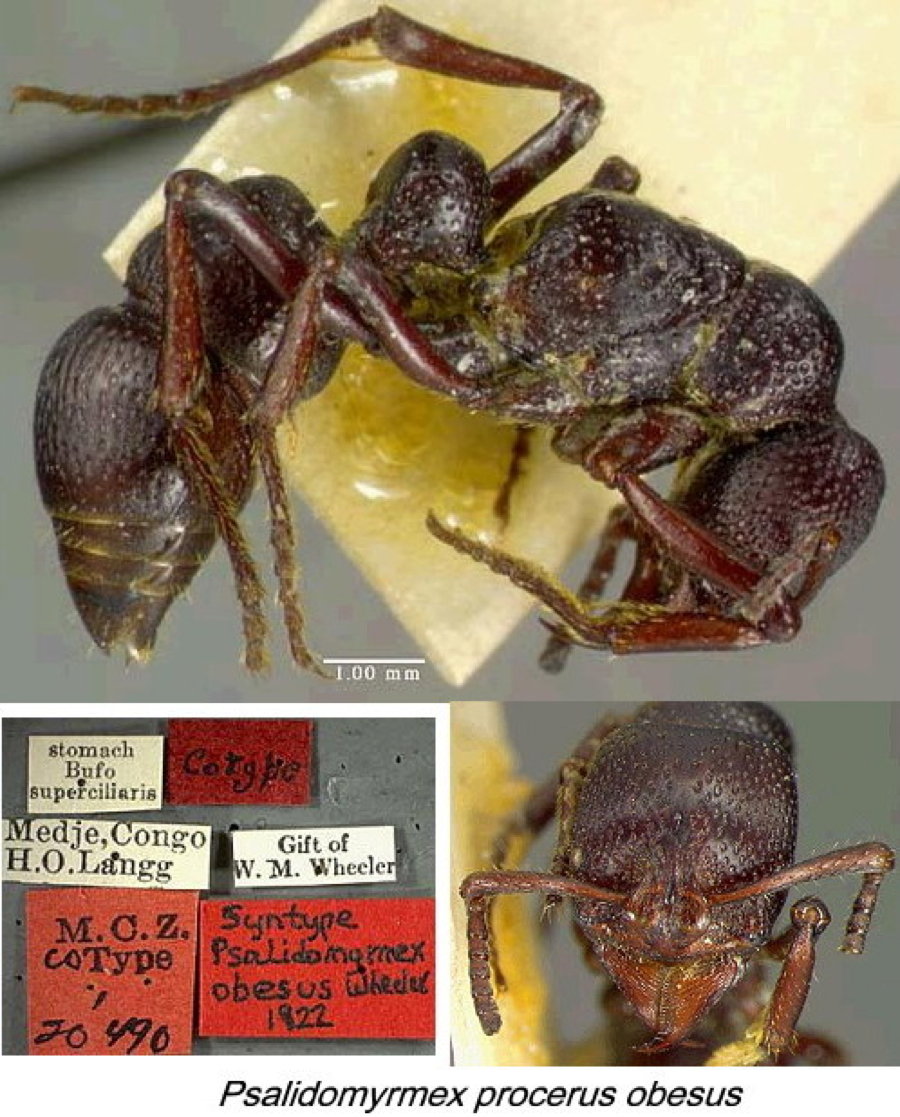Psalidomyrmex procerus Emery
  Type location Cameroun
(Psalidomyrmex procerus n.
sp., Emery, 1901a: 50, all forms, only worker is new; first described
by
Emery, 1899e: 471, queen & male as Psalidomyrmex foevolatus,
presumably collected at Mundame by Conradt Type location Cameroun
(Psalidomyrmex procerus n.
sp., Emery, 1901a: 50, all forms, only worker is new; first described
by
Emery, 1899e: 471, queen & male as Psalidomyrmex foevolatus,
presumably collected at Mundame by Conradt
junior synonyms
collarti (Psalidomyrmex
procerus Em. stirps collarti
n. st., Santschi, 1937g: 74, worker) from Zaïre, Ituri,
Matenda, A. Collart, 22.ix.1929 - see http://www.antweb.org/specimenImages.do?code=rmcaent000017735
obesus (Wheeler, 1922:
92, fig.19, see right, worker) from Zaïre - see below
longiscapus (Psalidomyrmex
longiscapus n. sp., Santschi, 1920b: 8, queen) from Gabon,
Samkita, F. Faure - see http://www.antweb.org/specimenImages.do?code=casent0915302
all forms described (see Bolton, 1995)  . .
|
 WORKER
- large, TL 11.4-16.2 mm; mandibles elongate-subtriangular, edentate.
Antennal scapes relatively short, head relatively broad, petiole
broader than long. Colour black (Bolton, 1975: 12, illustrated,
mandible only). Sculpturation of mandibles, legs, antennal scapes and
expanded lobes of frontal carinae always striate. WORKER
- large, TL 11.4-16.2 mm; mandibles elongate-subtriangular, edentate.
Antennal scapes relatively short, head relatively broad, petiole
broader than long. Colour black (Bolton, 1975: 12, illustrated,
mandible only). Sculpturation of mandibles, legs, antennal scapes and
expanded lobes of frontal carinae always striate.
Wheeler (1922) listed it also from Togo
(Bismarckburg, Conradt) and Zaïre.
The photomontage is of a cotype of Psalidomyrmex
obesus from Zaïre. The original photographs, together with
enlarged images, are from the MCZ, Harvard University, website at - MCZ link.
Bernard (1952, finding not listed by Bolton, 1975)
described it as apparently common in Cameroun and Congo. In Guinea
a small specimen, Nimba II-VI, was shorter (TL 11.8 ) than the type
from Cameroun (TL 15.2), colour black-grey rather than black-red, and
stronger abdominal sculpturation. Otherwise similar with the petiole
and thorax larger than other species. The antennae have good defining
characters (see group illustration). Hairs very sparse and brown-black.
Bolton (1975b) examined specimens from Cameroun ,
Yolé and Mt. Nkolodon (G. Terron) and Matute (B. Malkin). Also from Ghana,
at CRIG (B. Bolton; D. Leston), Kade, Atewa Forest Reserve and
Kukurantumi (D. Leston); Zaïre, Gabon and Uganda (Bolton, 1975b). A
specimen from Zaïre is pictured by Höldobler & Wilson (1990, page
92).
Presumably from work in Ivory Coast, reported to
feed on earthworms by Lévieux (1982), and to nest in rotten wood on the
ground (Bolton, 1975b).
Bolton & Brown (2002) reported findings from
Cameroun, Ottotomo Forest and Abong Mbang, by A. Dejean; Burundi,
by A. Dejean.
|